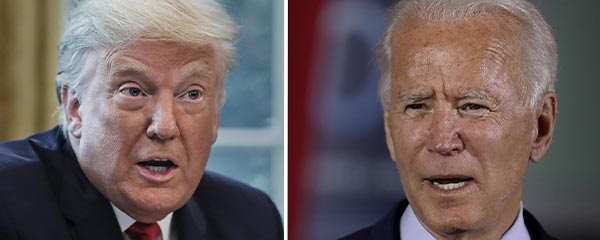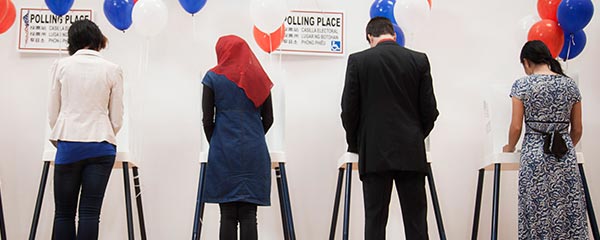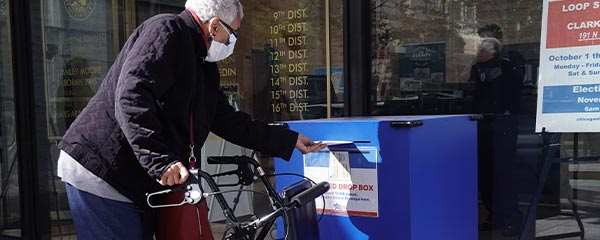Story Highlights
- 28% are satisfied with way things are going, up from 14% in September
- Six in 10 Republicans are satisfied, an increase from 26%
- President Trump's job approval rating at 46%
WASHINGTON, D.C. -- Though Americans remain largely dissatisfied with the way things are going in the U.S., the percentage who are satisfied has doubled since September to 28%. Still, satisfaction remains well below where it was earlier this year.
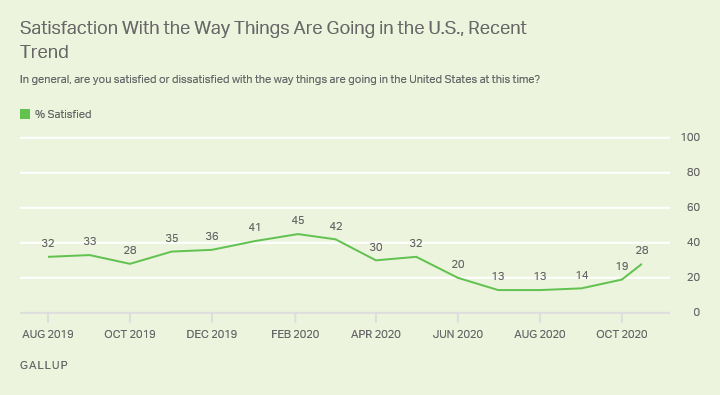
Line graph. In February, 45% of Americans were satisfied with the way things are going in the United States. That dropped to 30% in April amid the coronavirus pandemic and 13% in July and August. The current reading of 28% is up from 14% in September and 19% earlier this month.
The Oct. 16-27 poll finds Republicans are mostly responsible for the recent increase in satisfaction -- 60% are now satisfied, up from 26% in September. There has been a slight increase in satisfaction among independents and no meaningful change among Democrats. Greater Republican satisfaction may be a response to Trump's messaging about the nation "rounding the corner" on the coronavirus, the economic recovery since the spring shutdown, and the nomination of Amy Coney Barrett to the Supreme Court.
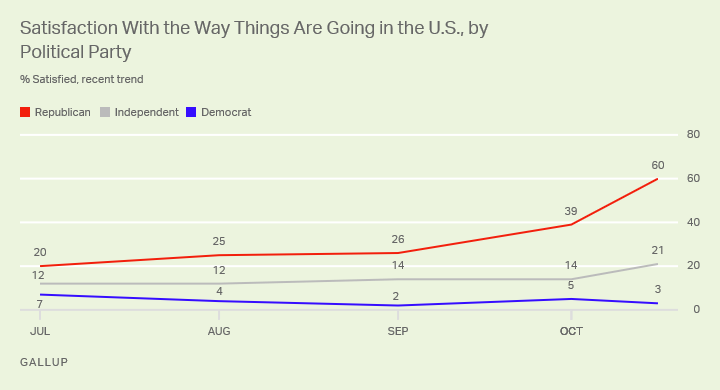
Line graph. Sixty percent of Republicans are satisfied with the way things are going in the U.S., up from 39% earlier this month and 26% in September. Satisfaction among independents has improved from 14% to 21%. The 3% of Democrats who are satisfied is not meaningfully different from the 5% in October or 2% in September.
Trump Job Approval at 46%
The poll also finds President Trump's job approval rating at 46% in the last measure before the election. His approval rating has fluctuated between 42% and 46% in Gallup's September and October polls, averaging 44%.
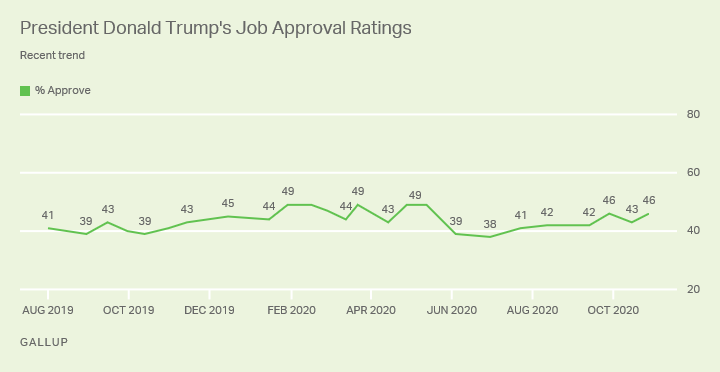
Line graph. 46% approve of the job Donald Trump is doing as president. His ratings have varied between 42% and 46% in the past two months. Earlier this year, he had several 49% readings as well as a 38% approval rating in July.
The latest reading sets another new standard for party polarization in a single poll -- 95% of Republicans and 3% of Democrats approve of the job Trump is doing as president. This is the first time a president's approval rating has shown a party gap in excess of 90 percentage points in a single Gallup poll. No president prior to Trump had a party gap higher than 86 points. In the final survey before President Barack Obama's reelection in 2012, 86 points separated Democratic and Republican approval of him.
| Poll dates | Republicans | Independents | Democrats | Rep-Dem gap | |||||||||||||||||||||||||||||||||||||||||||||||||||||||||||||||||||||||||||||||||||||||||||||||
|---|---|---|---|---|---|---|---|---|---|---|---|---|---|---|---|---|---|---|---|---|---|---|---|---|---|---|---|---|---|---|---|---|---|---|---|---|---|---|---|---|---|---|---|---|---|---|---|---|---|---|---|---|---|---|---|---|---|---|---|---|---|---|---|---|---|---|---|---|---|---|---|---|---|---|---|---|---|---|---|---|---|---|---|---|---|---|---|---|---|---|---|---|---|---|---|---|---|---|---|
| % | % | % | pct. pts. | ||||||||||||||||||||||||||||||||||||||||||||||||||||||||||||||||||||||||||||||||||||||||||||||||
| Trump | 2020 Oct 16-27 | 95 | 41 | 3 | 92 | ||||||||||||||||||||||||||||||||||||||||||||||||||||||||||||||||||||||||||||||||||||||||||||||
| Trump | 2020 Sep 30-Oct 15 | 94 | 35 | 4 | 90 | ||||||||||||||||||||||||||||||||||||||||||||||||||||||||||||||||||||||||||||||||||||||||||||||
| Trump | 2020 Jun 8-30 | 91 | 33 | 2 | 89 | ||||||||||||||||||||||||||||||||||||||||||||||||||||||||||||||||||||||||||||||||||||||||||||||
| Trump | 2020 Aug 31-Sep 13 | 92 | 36 | 4 | 88 | ||||||||||||||||||||||||||||||||||||||||||||||||||||||||||||||||||||||||||||||||||||||||||||||
| Trump | 2020 Sep 14-28 | 94 | 39 | 7 | 87 | ||||||||||||||||||||||||||||||||||||||||||||||||||||||||||||||||||||||||||||||||||||||||||||||
| Trump | 2020 Jul 1-23 | 91 | 34 | 4 | 87 | ||||||||||||||||||||||||||||||||||||||||||||||||||||||||||||||||||||||||||||||||||||||||||||||
| Trump | 2020 Feb 3-16 | 93 | 43 | 6 | 87 | ||||||||||||||||||||||||||||||||||||||||||||||||||||||||||||||||||||||||||||||||||||||||||||||
| Trump | 2020 Jan 16-29 | 94 | 42 | 7 | 87 | ||||||||||||||||||||||||||||||||||||||||||||||||||||||||||||||||||||||||||||||||||||||||||||||
| Trump | 2020 Apr 1-14 | 93 | 39 | 7 | 86 | ||||||||||||||||||||||||||||||||||||||||||||||||||||||||||||||||||||||||||||||||||||||||||||||
| Trump | 2019 Nov 1-14 | 90 | 38 | 4 | 86 | ||||||||||||||||||||||||||||||||||||||||||||||||||||||||||||||||||||||||||||||||||||||||||||||
| Trump | 2019 Sep 3-15 | 91 | 38 | 5 | 86 | ||||||||||||||||||||||||||||||||||||||||||||||||||||||||||||||||||||||||||||||||||||||||||||||
| Trump | 2019 Mar 1-10 | 90 | 33 | 4 | 86 | ||||||||||||||||||||||||||||||||||||||||||||||||||||||||||||||||||||||||||||||||||||||||||||||
| Trump | 2018 Nov 5-11 | 91 | 34 | 5 | 86 | ||||||||||||||||||||||||||||||||||||||||||||||||||||||||||||||||||||||||||||||||||||||||||||||
| Obama | 2012 Oct 29-Nov 4 | 6 | 51 | 92 | 86 | ||||||||||||||||||||||||||||||||||||||||||||||||||||||||||||||||||||||||||||||||||||||||||||||
| Gallup | |||||||||||||||||||||||||||||||||||||||||||||||||||||||||||||||||||||||||||||||||||||||||||||||||||
A slim majority of Americans, 52%, approve of the way Trump is handling the economy. The economy has typically been Trump's strongest issue, but the current reading is significantly below his personal best 63% from January.
Meanwhile, 40% approve of the president's response to the coronavirus, down slightly from 44% in September, but still remaining above his lowest approval of 36% on that issue in August. When the pandemic exploded in the U.S. in March, six in 10 approved of Trump's response.
Forty-four percent approve of his handling foreign affairs.
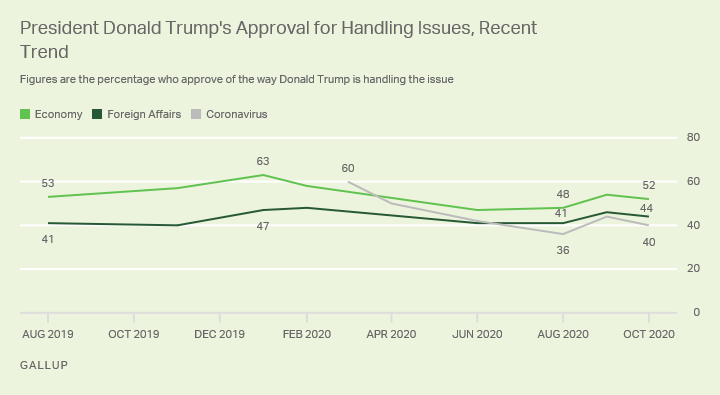
Line graph. Donald Trump is rated more highly for handling the economy, 52%, than he is for handling foreign affairs, 44%. His rating on handling the response to the coronavirus is lower than his other two issue ratings at 40%.
Electoral Implications
National satisfaction and presidential job approval, along with Americans' economic confidence, have proven to be reliable predictors of election outcomes involving incumbent presidents in the past. On satisfaction and job approval, Trump is below the level at which prior incumbents have been reelected, but also above the level at which two prior incumbents lost. On economic confidence, the current ratings measured earlier this month are similar to those in other elections in which incumbents have won a second term.
The current 28% satisfaction ratings sit squarely in between the 22% reading from 1992 (when the incumbent lost) and the 33% reading from 2012 (when the incumbent won). The 2012 reading is the lowest Gallup has measured at the time of an election won by incumbent. George W. Bush, Bill Clinton and Ronald Reagan won reelection in years when satisfaction was 39% or higher.
Presidential approval has been a strong indicator of incumbent reelection success. All presidents with job approval ratings above 50% at the time of the election won a second term. George W. Bush was reelected in 2004 with a 48% final job approval rating, though he registered several 50% readings in October of that year. The elder George Bush and Jimmy Carter had approval ratings below 40%, and they lost.
| Job approval | Satisfaction | Economic confidence | Result | ||||||||||||||||||||||||||||||||||||||||||||||||||||||||||||||||||||||||||||||||||||||||||||||||
|---|---|---|---|---|---|---|---|---|---|---|---|---|---|---|---|---|---|---|---|---|---|---|---|---|---|---|---|---|---|---|---|---|---|---|---|---|---|---|---|---|---|---|---|---|---|---|---|---|---|---|---|---|---|---|---|---|---|---|---|---|---|---|---|---|---|---|---|---|---|---|---|---|---|---|---|---|---|---|---|---|---|---|---|---|---|---|---|---|---|---|---|---|---|---|---|---|---|---|---|
| % Appove | % Satisfied | Index score | |||||||||||||||||||||||||||||||||||||||||||||||||||||||||||||||||||||||||||||||||||||||||||||||||
| 2020 (Trump) | 46 | 28 | -4 | TBD | |||||||||||||||||||||||||||||||||||||||||||||||||||||||||||||||||||||||||||||||||||||||||||||||
| 2012 (Obama) | 52 | 33 | -1 | Won | |||||||||||||||||||||||||||||||||||||||||||||||||||||||||||||||||||||||||||||||||||||||||||||||
| 2004 (G.W. Bush) | 48 | 44 | +3 | Won | |||||||||||||||||||||||||||||||||||||||||||||||||||||||||||||||||||||||||||||||||||||||||||||||
| 1996 (Clinton) | 54 | 39 | +23 | Won | |||||||||||||||||||||||||||||||||||||||||||||||||||||||||||||||||||||||||||||||||||||||||||||||
| 1992 (G.H.W. Bush) | 34 | 22 | -37 | Lost | |||||||||||||||||||||||||||||||||||||||||||||||||||||||||||||||||||||||||||||||||||||||||||||||
| 1984 (Reagan) | 58 | 48 | n/a | Won | |||||||||||||||||||||||||||||||||||||||||||||||||||||||||||||||||||||||||||||||||||||||||||||||
| 1980 (Carter) | 37 | 18 | n/a | Lost | |||||||||||||||||||||||||||||||||||||||||||||||||||||||||||||||||||||||||||||||||||||||||||||||
| Gallup did not measure satisfaction prior to 1979 or economic confidence prior to 1992. The 1980 satisfaction rating is an average of Nov. 1979 (19%) and Jan. 1981 (17%) polls. Gallup's final presidential approval ratings prior to 1984 were taken before October. These include: Carter (Sept. 1980), Ford (June 1976, 45%), Nixon (June 1972, 59%), Johnson (June 1964, 74%), Eisenhower (Aug. 1956, 72%), and Truman (June 1948, 40%). | |||||||||||||||||||||||||||||||||||||||||||||||||||||||||||||||||||||||||||||||||||||||||||||||||||
| Gallup | |||||||||||||||||||||||||||||||||||||||||||||||||||||||||||||||||||||||||||||||||||||||||||||||||||
Bush was able to win reelection with a sub-50% approval rating among national adults in 2004 because he benefited from higher turnout among his supporters -- 51% of likely voters approved of the job he was doing in the final 2004 preelection poll. Turnout does not appear to be working in Trump's favor this year, as his job approval rating is lower among likely voters -- 44% -- than it is among the general population.
Bottom Line
Gallup's final preelection poll finds a slightly more favorable political environment for President Trump than was the case last month. Still, key indicators of the national mood remain below the levels that have been associated with incumbent victories in the past. Trump's sub-50% overall job approval rating is especially problematic given that no prominent third-party candidates are running to split the anti-incumbent vote as occurred in some past elections, which means Trump likely needs 50% or more of the vote to win.
Greater turnout among Republicans -- something that has typically been the case -- could have helped improve Trump's chances of a second term, but that does not appear to be happening. His best hope at staying in the White House now rests on a sudden late surge among voters in his favor in the final days of the election campaign. The president's aggressive travel schedule shows he is trying his best to make that happen.
View complete question responses and trends (PDF download).
Learn more about how the Gallup Poll Social Series works.


